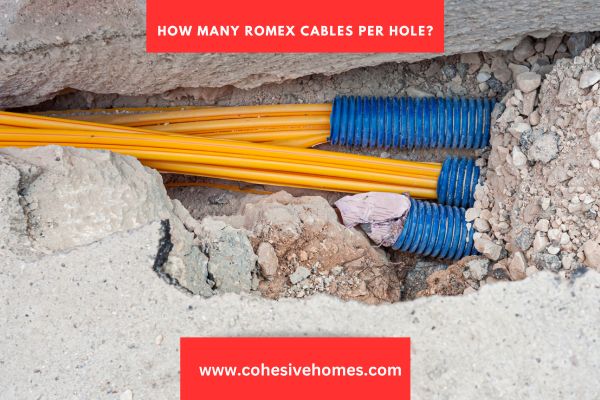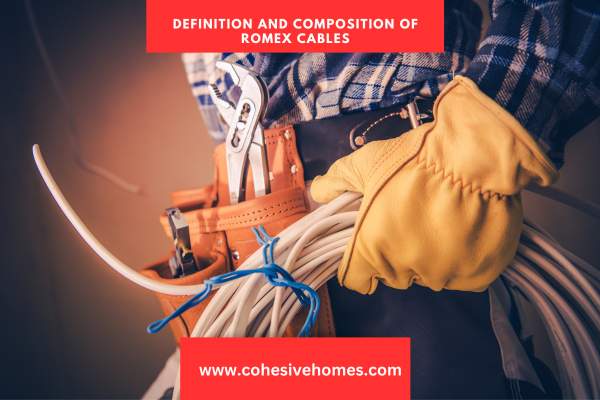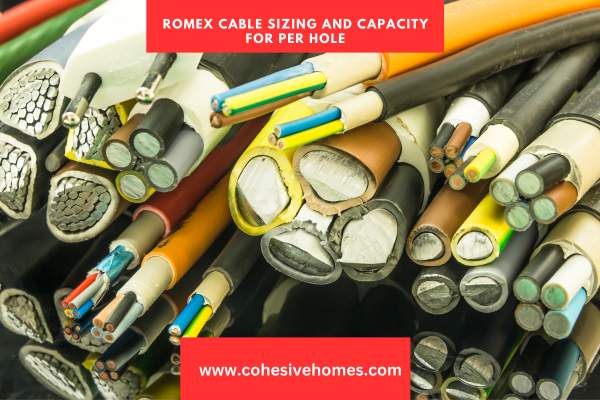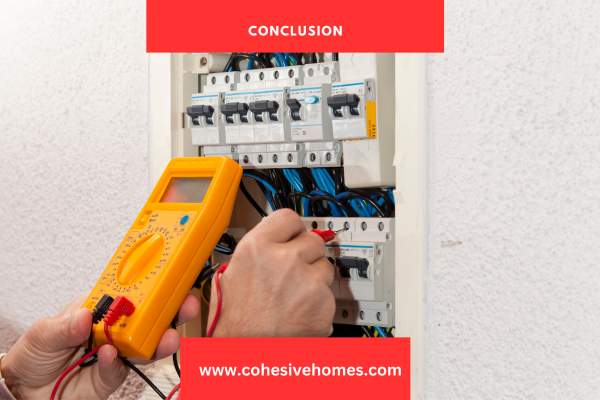Electrical wiring is an essential aspect of any modern building, enabling us to power our homes, offices, and various appliances that make our lives more convenient. Yet, behind the walls and within the conduit lies a complex network of cables, each serving a specific purpose.
When it comes to running electrical wires through holes, one question frequently arises: how many Romex cables should be passed through a single hole?
In this blog post, we will explore the considerations, guidelines, and best practices for determining the number of Romex cables per hole, shedding light on this common electrical installation query.
How many Romex cables per hole?

Determining the number of Romex cables per hole varies based on cable size, codes, and hole capacity.
While I can provide some general guidelines, it’s important to consult local electrical codes and regulations, as they may vary.
- Cable Size: The size or gauge of the Romex cable plays a significant role in determining the number of cables per hole. Smaller cables, such as 14 AWG (American Wire Gauge), generally require less space compared to larger cables like 10 AWG.
- Hole Capacity: The size of the hole you are working with is another crucial consideration. The diameter or dimensions of the hole should be sufficient to accommodate the desired number of Romex cables without causing damage or compromising their integrity.
- Electrical Codes: Local electrical codes and regulations set forth guidelines to ensure safe electrical installations. These codes often specify the maximum number of cables permitted per hole based on the cable size, hole capacity, and other factors. It is essential to consult these codes to adhere to the required standards.
As a general guideline, for standard-sized holes, the following recommendations can be considered:
- For 14 AWG Romex cables: Up to 9 cables per 3/4-inch hole.
- For 12 AWG Romex cables: Up to 7 cables per 3/4-inch hole
- For 10 AWG Romex cables: Up to 5 cables per 3/4-inch hole
Keep in mind that these guidelines are approximate and may vary depending on local codes, the specific circumstances of your installation, and any special requirements.
To ensure safety and compliance, it is always advisable to consult a licensed electrician or refer to local electrical codes before proceeding with any electrical work.
They can provide specific guidance tailored to your situation and ensure that your electrical installations meet the necessary standards.
Definition and composition of Romex cables

Romex cables, also known as non-metallic sheathed cables (NM cables), are a commonly used type of electrical wiring in residential and commercial buildings.
They are designed to safely transmit electrical power from a source to various outlets, switches, and appliances within a structure.
The composition of Romex cables consists of several key components that work together to provide reliable and efficient electrical conductivity.
At the core of a Romex cable are the conductor wires. These cables typically contain two or more insulated copper or aluminum conductors.
The number of conductors can vary depending on the specific application and the electrical requirements of the circuit.
The conductors are responsible for carrying the electrical current from the power source to the intended destination, such as a light fixture or an electrical outlet.
Surrounding the conductor wires is the outer jacket, or sheath, which serves as a protective layer for the cables.
The outer layer of Romex consists of a tough, non-metallic material, such as PVC (polyvinyl chloride), which provides insulation and mechanical protection.
The jacket shields the conductors from external factors like moisture, abrasion, and accidental damage, ensuring the safety and longevity of the electrical wiring system.
Manufacturers mark Romex cables with a designation indicating their specific configuration and capabilities.
These markings typically include information such as the cable’s gauge (AWG), the number of conductors, and any additional features or ratings.
This labeling helps electricians and installers identify and select the appropriate cable for their specific wiring needs, ensuring compliance with electrical codes and standards.
Romex Cable sizing and capacity for per hole

Cable sizing and capacity are crucial considerations in electrical installations to ensure proper performance, efficiency, and safety.
The size or gauge of a cable refers to the diameter of its conductive core, and it plays a significant role in determining the amount of electrical current the cable can safely carry.
Here’s a breakdown of cable sizing and capacity:
Wire Gauge (AWG)
The American Wire Gauge (AWG) system is commonly used to classify cable sizes. The AWG scale assigns a numerical value to each wire gauge, with smaller numbers indicating larger wire sizes. For example, a 12 AWG cable is thicker than a 14 AWG cable.
Current-Carrying Capacity
Each wire gauge has a specified current-carrying capacity, which is the maximum amount of electrical current that the cable can safely handle without overheating. This capacity is influenced by factors such as the cable’s conductor material, insulation type, and ambient temperature. Electrical codes and standards provide guidelines and tables that outline the allowable current-carrying capacities for different wire gauges.
Voltage Drop
Another consideration related to cable sizing is voltage drop. Voltage drop refers to the reduction in voltage that occurs as current flows through a cable. Excessive voltage drop can lead to decreased electrical efficiency and performance, especially over long cable runs. Proper cable sizing helps minimize voltage drop and ensures that the intended voltage reaches the connected devices or equipment.
Load Calculation
To determine the appropriate cable size for a specific electrical circuit, a load calculation is necessary. Load calculation involves assessing the electrical load or power requirements of the connected devices, appliances, or lighting fixtures. By considering factors such as the wattage, quantity, and utilization of the loads, the appropriate cable size can be selected to safely handle the expected current.
Derating Factors
In certain situations, derating factors may need to be applied to adjust the cable’s current-carrying capacity. Factors like ambient temperature, cable bundling, and specific installation conditions can impact a cable’s heat dissipation and thus require derating. Following electrical codes and guidelines ensures that the appropriate derating factors are considered.
Wire Management and Organization

Proper wire management and organization are essential aspects of any electrical installation.
Effective wire management ensures that cables are arranged in a neat and orderly manner, promoting safety, ease of maintenance, and efficient operation of the electrical system.
One important aspect of wire management is thoughtful cable routing. Careful planning and routing of cables help prevent tangling, interference, or accidental damage.
Cables should be routed along designated paths, such as conduit, cable trays, or studs, to keep them organized and protected.
It is important to avoid sharp bends or tight turns that can strain the cables or compromise their insulation.
Maintaining appropriate cable lengths is another key factor in wire management.
Keeping cables at the required length reduces clutter and maintains a clean installation.
Excessive slack or excessively long cables can create tripping hazards and make troubleshooting or future modifications more difficult.
Cutting cables to the required length while leaving some extra length for flexibility and adjustments ensures a tidy installation.
Proper cable identification is crucial for efficient wire management.
Labeling or marking cables with color-coded tags, labels, or heat-shrink sleeves helps with troubleshooting and maintenance procedures.
By identifying cables based on their function, circuit, or destination, it becomes easier to locate specific cables, perform repairs, or make modifications without confusion.
Securely fastening cables at regular intervals is vital for wire organization. Using appropriate cable clamps, clips, or ties helps prevent cables from hanging loosely or sagging, reducing the risk of accidental damage or interference with other equipment.
Cable fasteners should be installed in a way that does not compress or damage the cable insulation.
Maintaining proper separation and segregation of different types of cables is important.
This ensures that power cables and low-voltage signaling cables are kept apart to prevent electromagnetic interference and maintain signal integrity.
Special Cases and Considerations

In electrical installations, there are special cases and considerations that may require specific attention and approaches.
These situations involve unique challenges or requirements that go beyond standard wire management practices. Here are some special cases and considerations to keep in mind:
Limited Space or Tight Holes
In certain situations, you may encounter limited space or tight holes where running multiple Romex cables becomes challenging. In such cases, you may need to explore alternative wiring methods, such as using conduit or surface-mounted raceways.
These solutions can help accommodate the cables and provide the necessary protection while optimizing the available space.
Unique Installations
Special installations, such as outdoor or underground wiring, may require additional considerations.
Outdoor wiring needs to be protected against moisture, UV exposure, and physical damage. Underground installations may involve burying cables at the appropriate depth and using conduit or direct burial-rated cables.
It is crucial to follow local codes and regulations specific to these types of installations.
High-Temperature Environments
In areas with high temperatures, such as near ovens or industrial equipment, special wiring rated for those conditions may be required.
These cables are designed to withstand higher temperatures without degradation. Using heat-resistant insulation and selecting cables with the appropriate temperature ratings ensures safety and prevents damage to the wiring.
Special Equipment or Appliances
Some appliances or equipment may have unique electrical requirements. Examples include electric vehicles, high-power machinery, or specialized medical equipment.
It is important to consult manufacturer guidelines and electrical codes to determine the proper wiring methods, cable sizes, and any additional safety measures needed to accommodate these specific installations.
Fire-Rated Assemblies
In certain building structures, fire-rated assemblies are necessary to ensure fire safety and compliance. These assemblies involve maintaining the integrity of fire-rated walls, ceilings, or floors by using fire-rated cables and proper penetration sealing methods.
Adhering to fire safety regulations and consulting experts in fire protection is crucial for these installations.
Hazardous Locations
Hazardous locations, such as areas with flammable gases, vapors, or dust, require specialized wiring methods to mitigate the risk of ignition.
Wiring in these areas must meet specific explosion-proof or intrinsically safe requirements. It is essential to follow guidelines set forth by regulatory bodies and consult professionals with expertise in hazardous location installations.
When dealing with special cases and considerations, it is important to thoroughly research and understand the specific requirements for the given situation. Local codes, regulations, and industry standards should be followed to ensure safety, compliance, and proper functioning of the electrical system.
Seeking guidance from qualified professionals, such as electricians or engineers with experience in the relevant specialty, can provide valuable insight and expertise for these unique installations.
Conclusion

In conclusion, effective wire management and organization play a vital role in electrical installations.
By following proper practices and considering special cases and considerations, you can create a safe, efficient, and reliable electrical system.
Careful cable routing, appropriate cable lengths, clear identification, secure fastening, and proper separation of cables contribute to a well-organized installation that promotes ease of maintenance and minimizes the risk of accidents or interference.
Additionally, addressing special cases such as limited space, unique installations, high-temperature environments, special equipment, fire-rated assemblies, and hazardous locations ensures that specific requirements and safety measures are met.
Adhering to local codes and regulations and seeking guidance from qualified professionals further enhances the overall quality of the wire management and organization.
By prioritizing wire management, you can achieve an electrical system that not only meets safety standards but also facilitates future modifications and troubleshooting with ease.
FAQS
How can I effectively manage a large number of cables in my installation?
Group cables by function, use cable trays or raceways, and utilize cable management accessories like ties or clips to keep them organized.
Are there specific codes or regulations for wire management?
Yes, consult local electrical codes to ensure compliance with guidelines on cable spacing, separation, and protection.
How can I label cables for easier troubleshooting and maintenance?
Use color-coded labels or heat shrink sleeves and maintain a detailed cable schedule for accurate identification and documentation.
